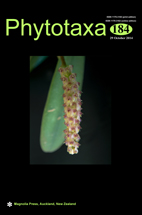Abstract
Cavinula Mann & Stickle is small genus presently comprising 25 taxa distinguished by the linear to round-elliptical valve shape, uniseriate striae, presence of nodules and distinctive terminal pores. Most often the species from the genus have been reported from colder northern or alpine oligotrophic aquatic systems, or moist sub-aerial habitats. Observation of samples from different localities reveals fourteen Cavinula taxa are distributed across North America. Descriptions of confirmed species including designated types are provided with regard to their taxonomy, autecology, and distribution in Canada and USA. Light and Scanning Electron Microscope observations of different samples and type material reveal high morphological variation within some of the taxa. Two and three morphotypes are recognized within C. cocconeiformis and C. pseudoscutiformis. Cavinula kernii and C. maculata are recognized as new species and formal description and differential diagnosis are presented. The biogeography of the genus Cavinula in North America is represented by three groups of species. The first group comprises taxa with more restricted distribution in oligotrophic, cold and/or alpine environments from the Arctic Archipelago and the Rocky Mountains in western North America. The second group comprises more tolerant species with broader distributions across a wider range of ecological conditions. The third group from south-eastern North America, represented by C. maculata, is found in low pH and specific conductance conditions with low nutrients. Globally, forty-one percent of the known taxa are present in North America. This number is subject to change after a better understanding of the different morphotypes and global taxa distributions.

